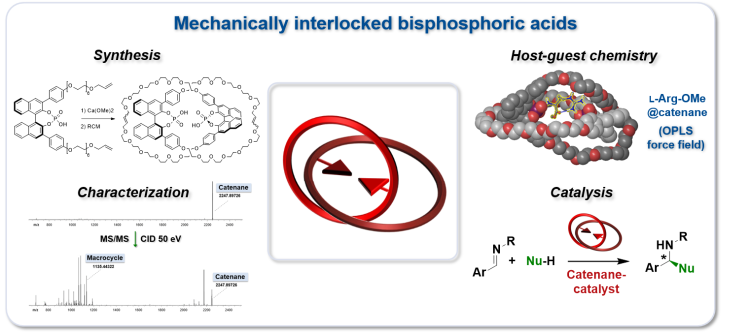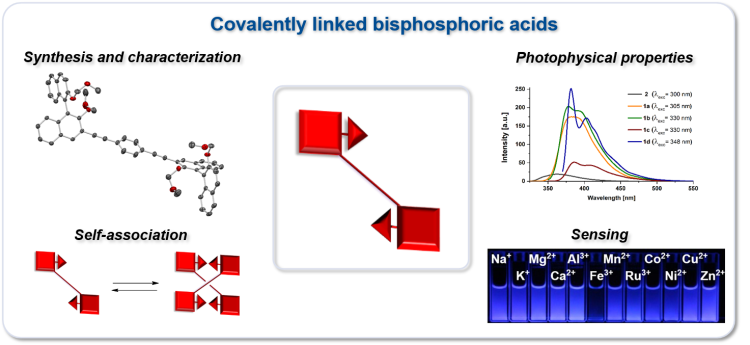Research topics
AK Niemeyer: Supramolecular Organocatalysis and Chemosensing
The focus of our current and future research is the development of innovative chemical catalysts and chemosensors. Our chemistry enables novel reactivities and selectivities by using multifunctional systems, with several functional groups acting in a cooperative fashion. Based on concepts from organic and supramolecular chemistry, we have developed different molecular architectures to generate such cooperative systems, ranging from covalently linked structures to mechanically interlocked molecules.
Supramolecular catalysis
Our main research focus is the application of interlocked molecules, such as rotaxanes and catenanes for organocatalysis.
As a first example, we have reported a novel [2]catenane featuring two chiral 1,1´-binaphthyl-phosphoric acids. This catenane was successfully used as a receptor for chiral diamine-guests and is the first example for a chiral catenane-based catalyst. For more information, please check our articles in Chem. Commun., Angew. Chem. Int. Ed. and Chem. Sci. ! Our lessons learnt from these project have now paved the way for using macrocycles in supramolecular catalysis. See our papers in Chem. Eur. J. and Beilstein J. Org. Chem. !
Recently, we have also extended this work towards the use of chiral rotaxanes for asymmetric catalysis. Please check our publications in Angew. Chem. Int. Ed. , Chem. Commun. and Chem. Eur. J.!
For overviews on interlocked molecules in catalysis and cooperative organocatalysis see our Minireviews in Synlett ChemCatChem, ChemPlusChem, Chem. Eur. J. , ChemPlusChem, Org. Chem. Front., Beilstein J. Org. Chem. and Nat. Rev. Chem.!

Other applications of interlocked molecules
Next to the application of interlocked molecules in catalysis, we have also used developed rotaxanes for switchable singlet oxygen production and as molecular transporters. Please see our publications in Commun. Chem. and Chem. Eur. J.! Also see our review on biomedical applications of interlocked molecules in Eur. J. Org. Chem. !

Chemosensing
We have generated a series of rigidly tethered bis-phosphoric acids, realizing that the nature of the tether has a profound influence on their properties. For an example of our synthetic work, please see our publications in Synthesis and J. Org. Chem.
This led to the identification of one preferred bis-phosphoric acid, which can be used for the chemoselective detection of ferric ions. Please see our publication in Chem. Eur. J.. We have also used these systems for the binding and array-based detection of amino-acids and amino-sugars. See our paper in Org. Lett., Chem. Eur. J. and Isr. J. Chem.!
Also, we have applied our covalently linked bisphosphoric acids for the generation of supramolecular double-helices. Please see our paper in Chem. Commun.!

Cooperation projects
Many of our publications would not have been possible without cooperation partners, for example Prof. Stephen Goldup, Prof. Stefan Grimme, Prof. Gebhard Haberhauer, Prof. Christian Merten and Prof. Cristian Strassert!
Next to our work in organic supramolecular chemistry, we also love collaborating in interdisciplinary projects. Examples can be found in our joint publications with Prof. Michael Giese, Prof. Xiaoyu Hu, Prof. Shirley Knauer, Prof. Ivo Leito, Prof. Rainer Meckenstock, Prof. Sebastian Schlücker and Prof. Torsten Schmidt.
AK Schmuck: Supramolecular materials
In continuation of the work by Prof. Carsten Schmuck, we have published a couple of papers based on work of PhDs and Postdocs of the Schmuck group. Please see the works in ACS Appl. Mater. Interfaces, Small, Chem. Eur. J., Beilstein J. Org. Chem. and Arkivoc!
Also, for remembering Carsten and his work, please see the review in ChemPlusChem and the special issue in Beilstein J. Org. Chem.!

